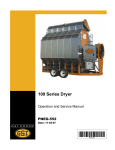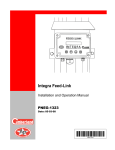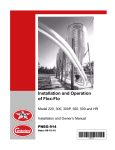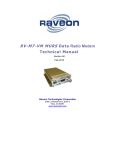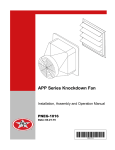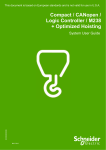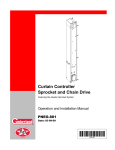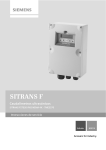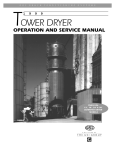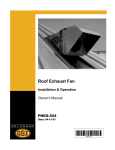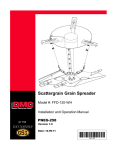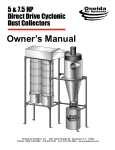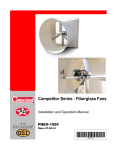Download Pneg-1708 - GSI Modular Tower Dryer
Transcript
GSI Modular Tower Dryer TM-1008, TM-1010, TM-1012 and TM-1015 Construction Manual PNEG-1708 Date: 08-01-11 PNEG-1708 2 PNEG-1708 GSI Modular Tower Dryer Table of Contents Contents Chapter 1 Introduction .......................................................................................................................................... 4 Chapter 2 Safety ..................................................................................................................................................... 5 Safety Guidelines .................................................................................................................................. 5 General Safety Statement ..................................................................................................................... 6 Electrical Power Supply ........................................................................................................................ 6 Chapter 3 Safety Decals ........................................................................................................................................ 7 Safety Decal # DC-GBC-1A .................................................................................................................. 8 Safety Decal # DC-1943 ....................................................................................................................... 9 Safety Decals # DC-985, DC-990 and DC-991 ................................................................................... 10 Safety Decals # DC-987, DC-988 and DC-989 ................................................................................... 11 Safety Decals # DC-1061 and 420-1473-8 ......................................................................................... 12 Safety Decals # DC-1063 and DC-1064 ............................................................................................. 13 Information Decals .............................................................................................................................. 14 Chapter 4 Dryer Overview and Specifications .................................................................................................. 15 Dimensions and Capacities for all Models .......................................................................................... 18 Dimensions - TM-1008 ........................................................................................................................ 19 Dimensions - TM-1010 ........................................................................................................................ 20 Dimensions - TM-1012 ........................................................................................................................ 21 Dimensions - TM-1015 ........................................................................................................................ 22 Chapter 5 Required Tools and Critical Tool Characteristics ........................................................................... 23 Critical Tool Characteristics ................................................................................................................ 23 Comprehensive Tool List .................................................................................................................... 28 Chapter 6 Unloading and Staging the Modules ................................................................................................ 29 Chapter 7 Placing and Installing the Base/Unload Module .............................................................................. 30 Base/Unload Module Placement Considerations ................................................................................ 30 Securing the Unload Module ............................................................................................................... 32 Chapter 8 Assembling Ladders, Platforms and Catwalks ............................................................................... 34 Crate as Work Bench .......................................................................................................................... 34 Installing Outside Ladder with Safety Cage ........................................................................................ 35 Overview Catwalk and Platform Assembly ......................................................................................... 39 Attaching Catwalks and Platforms to Dryer Modules .......................................................................... 40 Chapter 9 Burner/Blower Module - Special Considerations ............................................................................ 48 Chapter 10 Lifting and Stacking the Modules ................................................................................................... 51 Overview for Safety ........................................................................................................................... 51 Recommended Stacking Order: Model 800 Series Dryer ................................................................. 52 Recommended Stacking Order: Model 1010 Series Dryer ............................................................... 53 Recommended Stacking Order: Model 1200 Series Dryer ............................................................... 54 Recommended Stacking Order: Model 1500 Series Dryer ............................................................... 55 Lifting ................................................................................................................................................. 56 Chapter 11 Electrical Connections ..................................................................................................................... 64 Electrical Overview Minimal Connections .......................................................................................... 64 Air Switch ........................................................................................................................................... 65 Flame Sensor and Ignitor Wires (Spark Plug) ................................................................................... 67 Bindicator, Outside Overheat and Moisture Sensor .......................................................................... 69 Plenum Temperature ......................................................................................................................... 70 Chapter 12 Gas Pipe Train Overview ................................................................................................................. 71 Gas Pipe Train (Natural or LP) Overview Minimal Connections ........................................................ 71 Chapter 13 Finishing Touches: Removing Wrinkles and Dents from Screens .............................................. 73 Chapter 14 Warranty ............................................................................................................................................ 75 PNEG-1708 GSI Modular Tower Dryer 3 1. Introduction READ THIS MANUAL carefully to learn how to properly use and install equipment. Failure to do so could result in personal injury or equipment damage. INSPECT the shipment immediately upon arrival. The customer is responsible for ensuring that all quantities are correct. The customer should report and note any damage or shortage on the bill of lading to justify their claim to the transport company. THIS MANUAL SHOULD BE CONSIDERED a permanent part of your equipment and should be easily accessible when needed. This warranty provides you the assurance that the company will back its products when defects appear within the warranty period. In some circumstances, the company also provides field improvements, often without charge to the customer, even if the product is out of warranty. Should the equipment be abused, or modified to change its performance beyond the factory specifications, the warranty will become void and field improvements may be denied. 4 PNEG-1708 GSI Modular Tower Dryer 2. Safety Safety Guidelines This manual contains information that is important for you, the owner/operator, to know and understand. This information relates to protecting personal safety and preventing equipment problems. It is the responsibility of the owner/operator to inform anyone operating or working in the area of this equipment of these safety guidelines. To help you recognize this information, we use the symbols that are defined below. Please read the manual and pay attention to these sections. Failure to read this manual and its safety instructions is a misuse of the equipment and may lead to serious injury or death. This is the safety alert symbol. It is used to alert you to potential personal injury hazards. Obey all safety messages that follow this symbol to avoid possible injury or death. DANGER WARNING DANGER indicates a hazardous situation which, if not avoided, will result in death or serious injury. WARNING indicates a hazardous situation which, if not avoided, could result in death or serious injury. CAUTION CAUTION, used with the safety alert symbol, indicates a hazardous situation which, if not avoided, could result in minor or moderate injury. NOTICE NOTICE is used to address practices not related to personal injury. PNEG-1708 GSI Modular Tower Dryer 5 2. Safety General Safety Statement Our foremost concern is your safety and the safety of others associated with tower dryer. This manual is to help you understand safe operating procedures and some problems that may be encountered by the operator and other personnel. As owner and/or operator, you are responsible to know what requirements, hazards and precautions exist and inform all personnel associated with the equipment or in the area. Safety precautions may be required from the personnel. Avoid any alterations to the equipment, which may produce a very dangerous situation, where SERIOUS INJURY or DEATH may occur. You should consider the location of the tower dryer site relative to power line locations or electrical transmission equipment. Contact your local power company to review your installation plan or for information concerning required equipment clearance. Clearance of portable equipment that may be taken to the tower dryer site should also be reviewed and considered. Any electrical control equipment in contact with the tower dryer should be properly grounded and installed in accordance with National Electric Code provisions and other local or national codes. This product is intended for the use of grain drying. Any other use is a misuse of the product. This product has sharp edges, which may cause serious injury. To avoid injury, handle sharp edges with caution and always use proper protective clothing and equipment. Sidewall bundles or sheets must be stored in a safe manner. The safest method of storing sidewall bundles is laying horizontally with the arch of the sheet upward, like a dome. Sidewall sheets stored on edge must be secured so that they cannot fall over and cause injury. Use care when handling and moving sidewall bundles. Personnel operating or working around equipment should read this manual. This manual must be delivered with equipment to its owner. Failure to read this manual and its safety instructions is a misuse of the equipment. NOTE: A careful operator reduces risk of personal injury and equipment damage. Electrical Power Supply GSI recommends you contact your local power company and request that a representative inspect the dryer installation. Be sure the wiring is compatible with the power company’s system and that adequate power is supplied to the dryer. 6 PNEG-1708 GSI Modular Tower Dryer 3. Safety Decals Some of the required safety decals are placed on the dryer before shipping. The remainder are placed on the dryer during electrical installations. The purpose of the safety decals is to immediately alert all personnel to the hazards of an operating dryer. The safety decal does not replace the need for all personnel to know and understand safe dryer operations and requirements. Read the “Dryer Operations and Service Manual”. NOTE: Safety decals should be read and understood by all people in or around the dryer area. Safety decals on Pages 8-13 identify and give the location of all safety decals that should be on each tower dryer. Safety decals are listed in numerical order. If the safety decals on the following pages are not on the dryer, or if they are damaged, immediately contact GSI for replacement safety decals. GSI Decals 1004 E. Illinois St. Assumption, IL. 62510 Phone: 1-217-226-4421 PNEG-1708 GSI Modular Tower Dryer 7 3. Safety Decals Safety Decal # DC-GBC-1A Location of Decals English and spanish decals are placed on inside of tower roof access port before shipping. Tower roof access port with decals in place. Rotating flighting will kill or dismember. Flowing material will trap and suffocate. Crusted material will collapse and suffocate. Keep clear of all augers. DO NOT ENTER this bin! If you must enter the bin: 1. Shut off and lock out all power. 2. Use a safety harness and safety line. 3. Station another person outside the bin. 4. Avoid the center of the bin. 5. Wear proper breathing equipment or respirator. Inside view - Access port installed with decals in place. Failure to heed these warnings will result in serious injury or death. DC-GBC-1A Outside view - Access port installed with decals in place. 8 PNEG-1708 GSI Modular Tower Dryer 3. Safety Decals Safety Decal # DC-1943 Location of Decal On outside of main power box and inside main power box door. Example - Electrical control system HIGH VOLTAGE. HAUTE TENSION. Will cause injury or death. Causera des blessures ou la mort. Lockout power before servicing. Bloquez le courant avant de faire l’entretien. DC-1943 PNEG-1708 GSI Modular Tower Dryer 9 3. Safety Decals Safety Decals # DC-985, DC-990 and DC-991 Location of Decal Inside main power box door, on same side as main electrical disconnect. 10 PNEG-1708 GSI Modular Tower Dryer 3. Safety Decals Safety Decals # DC-987, DC-988 and DC-989 Location of Decal Inside main power box door, on same side as main electrical disconnect. PNEG-1708 GSI Modular Tower Dryer 11 3. Safety Decals Safety Decals # DC-1061 and 420-1473-8 Location of Decal On outside of heat module door. WARNING! Flame and pressure beyond door. May cause serious injury. Do not enter when dryer is running. DC-1061 420-1473-8 12 PNEG-1708 GSI Modular Tower Dryer 3. Safety Decals Safety Decals # DC-1063 and DC-1064 Location of Decal On outside of cool module door. WARNING! High speed belt drive operating overhead. Can cause serious injury. Keep head and hands clear. Do not enter when dryer is running. DC-1064 PNEG-1708 GSI Modular Tower Dryer CAUTION! Airborne particles during operation. May impair vision and breathing. Do not enter when dryer is running. DC-1063 13 3. Safety Decals Information Decals Nameplate for Main Power Box Location of Decal Inside main power box door, on same side as main electrical disconnect. Example - Information decal 14 PNEG-1708 GSI Modular Tower Dryer 4. Dryer Overview and Specifications All models of the GSI Modular Tower Dryer include a base/unload module, a burner/blower module, a roof module and one or more heat modules. Heat modules can be “empty” or with turners based on owner preference. Module 1 on ALL models. NOTE: New dryers ship with corrugated sheets. Figure 4A Base/Unload Module Figure 4B Burner/Blower Module PNEG-1708 GSI Modular Tower Dryer 15 4. Dryer Overview and Specifications Figure 4C Heat Module - w/ Turners Figure 4D Empty Heat Module 16 PNEG-1708 GSI Modular Tower Dryer 4. Dryer Overview and Specifications Figure 4E Heat Module - w/ Door Kit Figure 4F Roof Module PNEG-1708 GSI Modular Tower Dryer 17 4. Dryer Overview and Specifications Dimensions and Capacities for all Models There are four (4) models of the GSI Modular Tower Dryer. Each model is 10' 10" in diameter. 1. TM-1008 2. TM-1010 3. TM-1012 4. TM-1015 Model 18 TM-1008 TM-1010 TM-1012 TM-1015 900 1125 1350 1690 BPH Capacity (20%-15%) 542 670 720 1010 BPH Capacity (25%-15%) 800 1000 1200 1500 BPH (Set in Maximum Cool) (20%-15%) 480 600 720 900 BPH (Set in Maximum Cool) (25%-15%) 900 1125 1350 1690 PNEG-1708 GSI Modular Tower Dryer 4. Dryer Overview and Specifications Dimensions - TM-1008 Total weight = 18000 lbs. NOTE: Please refer to Page 51 for individual section weights. Module - 5 Roof module (See Figure 4F on Page 17.) Module - 4 Heat module - w/ turners (See Figure 4C on Page 16.) Module - 3 Heat module - w/ door kit (See Figure 4E on Page 17.) Module - 2 Heat module - burner/blower (See Figure 4B on Page 15.) Module - 1 Base/unload (See Figure 4A on Page 15.) M-1008T - Five (5) modules total, usually ships on two (2) trucks. All five (5) modules are 10'-10" in diameter. The 1008 model includes a platform at the base/unload, ladders and safety cages to a stepover platform, ladders and safety cages to a full catwalk and ladders and safety cages to the roof access. Figure 4G TM-1008 PNEG-1708 GSI Modular Tower Dryer 19 4. Dryer Overview and Specifications Dimensions - TM-1010 Total weight = 21645 lbs. NOTE: Please refer to Page 51 for individual section weights. Module - 6 Roof module (See Figure 4F on Page 17.) Module - 5 Heat module - empty (See Figure 4D on Page 16.) Module - 4 Heat module - w/ turners (See Figure 4C on Page 16.) Module - 3 Heat module - w/ door kit (See Figure 4E on Page 17.) Module - 2 Heat module - burner/blower (See Figure 4B on Page 15.) Module - 1 Base/unload (See Figure 4A on Page 15.) M-1010T - Six (6) modules total, usually ships on two (2) trucks. All six (6) modules are 10'-10" in diameter. The 1010 model includes a platform at the base/unload, ladders and safety cages to three (3) full catwalks and ladders and safety cages to the roof access. Figure 4H TM-1010 20 PNEG-1708 GSI Modular Tower Dryer 4. Dryer Overview and Specifications Dimensions - TM-1012 Total weight = 23095 lbs. NOTE: Please refer to Page 51 for individual section weights. Module - 7 Roof module (See Figure 4F on Page 17.) Module - 6 Heat module - empty (See Figure 4D on Page 16.) Module - 5 Heat module - w/ turners (See Figure 4C on Page 16.) Module - 4 Heat module - empty (See Figure 4D on Page 16.) Module - 3 Heat module - w/ door kit (See Figure 4E on Page 17.) Module - 2 Heat module - burner/blower (See Figure 4B on Page 15.) Module - 1 Base/unload (See Figure 4A on Page 15.) M-1012T - Seven (7) modules total, usually ships on three (3) trucks. All seven (7) modules are 10'-10" in diameter. The 1012 model includes a platform for the base/unload module, ladders and cages to a full catwalk stepover platform, ladders and cages to three (3) catwalks and ladders and cages to the roof access. Figure 4I TM-1012 PNEG-1708 GSI Modular Tower Dryer 21 4. Dryer Overview and Specifications Dimensions - TM-1015 Total weight = 24545 lbs. NOTE: Please refer to Page 51 for individual section weights. Module - 8 Roof module (See Figure 4F on Page 17.) Module - 7 Heat module - empty (See Figure 4D on Page 16.) Module - 6 Heat module - empty (See Figure 4D on Page 16.) Module - 5 Heat module - w/ turners (See Figure 4C on Page 16.) Module - 4 Heat module - empty (See Figure 4D on Page 16.) Module - 3 Heat module - w/ door kit (See Figure 4E on Page 17.) Module - 2 Heat module - burner/blower (See Figure 4B on Page 15.) Module - 1 Base/unload (See Figure 4A on Page 15.) M-1015T - Eight (8) modules total, usually ships on three (3) trucks. All eight (8) modules are 10'-10" in diameter. The 1015 model includes a platform for the base/unload module, ladders and cages to a full catwalk stepover platform, ladders and cages to three (3) catwalks and ladders and cages to the roof access. Figure 4J TM-1015 22 PNEG-1708 GSI Modular Tower Dryer 5. Required Tools and Critical Tool Characteristics Equipping the field crew with the right tools is essential for a smooth installation. The GSI Modular Tower Dryer requires a number of standard tools. Please pay particular attention to the following item descriptions as the characteristics of the following tools are extremely important information for proper installation. A comprehensive list of tools required to assemble and install the GSI Modular Tower Dryer is included later in this chapter. Critical Tool Characteristics 1. 1-1/8" Hammer drill star bit at least 12" long is REQUIRED. While the anchor bolts are 1" in diameter, the holes for the anchor bolts MUST be 1-1/8" in diameter to allow room for the required epoxy. Additionally, anchor bolts must be sunk deep enough so that no more than 2"-3" is above the plate. An air compressor hose is needed to blow out the dust from the holes prior to dropping in the anchor bolts and epoxy. (See Figure 5A.) 2. Air compressor with hose: After drilled the holes for the anchor bolts, an air compressor with hose is REQUIRED in order to blow all dust and debris out of the holes. Figure 5A Anchor Bolts Sunk - No More than 3" Remains above Plate 3. Punches: 1/4" Line up punches - at least 8 5/8" line up punches - at least 8 Ideally, during the installation process, crews will work in two (2) person teams with one team working inside the dryer and one team working outside the dryer. Each crew member should have at least two (2) punches available to them. Punches should be long enough to provide significant leverage to the user and should have narrow and pointed tips to facilitate the initial punch placement. (See Figure 5B and Figure 5C on Page 24.) PNEG-1708 GSI Modular Tower Dryer 23 5. Required Tools and Critical Tool Characteristics Figure 5B Line Up Punch and Hammer Figure 5C Line Up Punch Inserted Through Connecting Channels of Dryer 24 PNEG-1708 GSI Modular Tower Dryer 5. Required Tools and Critical Tool Characteristics 4. Socket sets and impact wrenches: • 3/8" Drive 1/2" socket set • 3/8" Drive 9/16" socket set • 1/2" Drive socket set • 15/16" Deep well 1/2" drive sockets • 1/2" Deep well 1/2" drive sockets • Short 1/2" 1/2" drive sockets • 9/16" Deep well 1/2" drive sockets • 1/2" Impact wrenches • 3/8" Drive extensions (6" to 10") for 9/16" shallow socket Accessing the bolts that connect sections of the dryer together requires passing through the hole in the channel as shown in Figure 5D. When installing, in all possible situations, place the impact on the bolt. Do NOT tighten the nut as it will not lock down on the ring. Always tighten the bolt. (See Figure 5D.) Figure 5D Connecting channels often requires the use of socket extensions. Please plan accordingly. PNEG-1708 GSI Modular Tower Dryer 25 5. Required Tools and Critical Tool Characteristics 5. Laser transit level tool: After placing the unload/base module on the concrete foundation and establishing its proper orientation to other equipment it must be leveled. GSI strongly recommends using a Laser transit leveling tool to level the unit. (See Figure 5E.) If a Laser transit is not available, a carpenter’s level may be used. It is critical to establish the base/unload module as level. Even a minor deviation at this level will be a significantly greater deviation at the top section. Therefore, pay particular attention to confirming the levelness of the base/unload module. Shims are available to assist with leveling the base/unload module. (See Figure 5F.) Figure 5E Laser Transit Level Figure 5F 26 PNEG-1708 GSI Modular Tower Dryer 5. Required Tools and Critical Tool Characteristics a. Compression channel: Regardless of what leveling tool is used, the proper reference point for leveling the unload module of the dryer is the Compression Channel and NOT the base/leg plates on the concrete. See Figure 5G for reference. The Compression Channel is the “ledge” around the unload module of the dryer. Use this as the reference point for leveling the unit. Do NOT use base plates/feet to determine whether or not unit is level. Compression channel ledge Figure 5G Unload Module with Compression Channel Marked PNEG-1708 GSI Modular Tower Dryer 27 5. Required Tools and Critical Tool Characteristics Comprehensive Tool List • C6 Epoxy gun • 1/4" Line up punches • 1/2" x 9/16" Box end combination wrenches • 1/2" Open end wrenches • 9/16" Open end wrenches • 32 OZ Ball peen hammers • 5/8" Line up punches • Small pry bars • 3/8" Drive socket and extension • 3/8" Drive 1/2" socket set • 3/8" Drive 9/16" socket set • 1/2" Drive socket set • 4' Level • Vice grips • 25' Tape measures • 15/16" Wrenches • 15/16" Deep well 1/2" drive sockets • 1/2" Deep well 1/2" drive sockets • Short 1/2" 1/2" drive sockets • 9/16" Deep well 1/2" drive sockets • Caulk gun and 2 tubes of clear silicone • 36" Pipe wrenches (rigid aluminum) • 48" Pipe wrench (rigid aluminum) • 18" Pipe wrenches • Torque wrench (all 3/8" grade 8 bolts will need 45 ft./lbs.) • 20' Ladders • 6' Ladders • 3/8" High speed drill bits • 5/16" High speed drill bits • 1/2" Impact wrenches • 1/2" Drills • 1-1/2" Sockets • Cordless sawzall • 1-1/2" Hammer drill • 1-1/8" Bits (hammer drill star bits) • 3/8" and 5/16" Bit for impact driver • 100' with a four (4) way box • Air compressor with hose 28 PNEG-1708 GSI Modular Tower Dryer 6. Unloading and Staging the Modules 1. Place modules on ground that is as solid and level as possible. Soft ground/grass will make preparation for installation more difficult. Concrete or gravel ground is preferable for pre-installation work. If no gravel or concrete area is available for staging the modules, consider placing the modules on 2 x 4’s or other blocking material to prevent the modules from sinking into the ground. 2. Place modules next to sequential modules (i.e. place Module 2 near Module 3 and Module 3 near Module 4, etc.) to make the stacking and connection of multiple modules easier. 3. Leave at least 4' to 5' of space between each module. Catwalks and/or platforms are attached to appropriate modules before modules are stacked upon each other and lifted into place. (See Figure 6A.) NOTE: Leave adequate space between modules to attach platforms and catwalks. NOTE: Concrete and gravel make the best staging ground. Figure 6A Unload and Staging Considerations PNEG-1708 GSI Modular Tower Dryer 29 7. Placing and Installing the Base/Unload Module Base/Unload Module Placement Considerations If the concrete foundation is ready and adequately cured, place the base/unload module on it and take careful and complete consideration of the surrounding equipment. Be sure to consider any planned options such as augers and any potential equipment to be added later. 1. Consider the location of the electrical box and control panel. Orient base/unload module so that personnel will have adequate and safe access to the electrical box and control panel. Remember, the Vision control box can be remote mounted. (See Figure 7A.) 2. Consider any auxiliary equipment that will be used with the GSI Modular Dryer. One set of X-braces on the unload may be removed without compromising structural integrity to allow for easier access. 3. Ensure that there is adequate overhead clearance for the entire tower dryer height and that the clearance between the dryer walls and other equipment is sufficient to allow for catwalks and/or platforms. (See Figure 7B on Page 31.) Figure 7A 30 PNEG-1708 GSI Modular Tower Dryer 7. Placing and Installing the Base/Unload Module Figure 7B Consider overhead clearance for the entire height of the dryer. 4. Ladder brackets are not pre-installed on modules. Consider installation location of ladders and brackets. Note that ladder brackets will be offset at each catwalk and will not line up in a straight line. (See Figure 7C.) IMPORTANT: When planning dryer location, ladders brackets will serve as good reference point for where catwalks and/or platforms will be placed higher up on the dryer. Be sure to allow for adequate spacing and clearance between the module dryer wall AND the platforms and/or catwalks that will be attached higher up and any other equipment in the area. Figure 7C Ladder Brackets - Indentify location on each module and surrounding equipment considerations. PNEG-1708 GSI Modular Tower Dryer 31 7. Placing and Installing the Base/Unload Module Securing the Unload Module 1. After determining the orientation of the unload module, use a 1-1/8" drill bit at least 12" long to drill holes for the anchor bolts. NOTE: Anchor bolts are 1" in diameter but the hole for them must be 1-1/8" in diameter to allow for the required epoxy. NOTE: It may be necessary to loosen or remove the bolts on the X-braces to gain easier access to the holes for the anchor bolts. If X-braces are removed or loosened to drill the anchor bolt holes, be sure to tighten the X-braces again when done. While it is normal to encounter rebar on occasion when drilling the holes for anchor bolts, should this happen more than 3 or 4 times, it is necessary to contact GSI for CAUTION splice plates to complete the drilling of the anchor bolt holes. (See Figure 7D.) Figure 7D 2. Use a laser transit to level the unload module. IMPORTANT: ALWAYS use the compression channel as the point of reference for establishing the levelness of the unit. Never use the feet/anchor plates to determine levelness. (See Figure 7E.) Figure 7E 32 PNEG-1708 GSI Modular Tower Dryer 7. Placing and Installing the Base/Unload Module NOTE: Shims are provided to assist with leveling if necessary. (See Figure 7F.) Figure 7F 3. After drilling the holes, all debris and fine material must be removed from the holes. 4. Use a compressed air hose to blow the dust and debris out. Then, drop anchor bolt in holes to confirm depth is adequate. 5. Once the unit is level, fill anchor bolt holes approximately 1/2" full with the provided epoxy. Press anchor bolts in holes. (See Figure 7G.) NOTE: Epoxy should ooze up and out of the hole at the base of the plate. If it does not, add epoxy and repeat. No more than 2" to 3" of the bolt should remain above the plate. (See Figure 7G.) 6. After all anchor bolt holes have been filled with epoxy and all anchor bolts have been inserted into the holes to the proper depth, allow epoxy to set for 4 to 6 hours before installing and tightening nuts or stacking another module of the dryer on top of it. Do NOT remove more than one set of X-braces on the base/unload module as doing so may compromise the structural integrity of the dryer. One set may be removed to CAUTION accommodate auxiliary equipment. Figure 7G PNEG-1708 GSI Modular Tower Dryer 33 8. Assembling Ladders, Platforms and Catwalks Crate as Work Bench Because the base/unload module requires the epoxy to set for a MINIMUM of 4 hours before other modules can be set on top of it, this is an excellent time to begin assembly of the ladders, platforms and catwalks. Once the crate is empty, use a hammer to pound the exposed nails and/or staples back into the frame so that the surface is smooth. The crate makes an excellent work bench for assembling items throughout the installation process. (See Figure 8A and Figure 8B.) Figure 8A Crate as Work Bench Once the modules have been staged, open the crate that shipped with the dryer modules. The crate contains catwalk and/or platform materials, ladders and safety cages, as well as the hoses for pipe train. Optional items such as an auger kit will also ship in crates. Installation instructions for optional accessories are in separate installation manuals. Unload the materials from the crate and place them nearby in like-item groups (i.e. gas train pipes together, catwalk and platform flooring together, etc). (See Figure 8B.) Figure 8B Shipping Crate 34 PNEG-1708 GSI Modular Tower Dryer 8. Assembling Ladders, Platforms and Catwalks Installing Outside Ladder with Safety Cage Outside Ladder Bracket Outside ladder brackets are not pre-installed prior to shipping. Pre-assemble safety cages on the ground prior to attaching to the dryer. Top Safety Cage Pre-assemble the top safety cage as follows. (See Figure 8C, Figure 8D below and Figure 8F to Figure 8H on Page 36.) 1. Snug bolt one formed ladder section to two (2) outside ladder stiffeners. Snug bolt four (4) safety cage brackets to outside ladder stiffeners. (See Figure 8C.) Figure 8C 2. Bolt pairs of safety cage hoop halves together. (See Figure 8D.) Figure 8D PNEG-1708 GSI Modular Tower Dryer 35 8. Assembling Ladders, Platforms and Catwalks 3. Snug bolt safety cage hoops to safety cage brackets. (See Figure 8E and Figure 8F.) Figure 8E Figure 8F 4. Snug bolt seven (7) vertical supports to safety cage hop halves. (See Figure 8G.) 5. Snug bolt top safety cage assembly to outside ladder brackets. (See Figure 8G.) 6. Tighten all bolts. 7. Use splice plate between ladders sections to connect. (See Figure 8H.) Figure 8G 36 Figure 8H WARNING LADDER BOLTS - insert bolts toward outside of ladder, so climbers do not snag on bolt shafts. WARNING Install all formed ladder sections so rungs with rough, textured side for gripping are on top, so climbers do not slip. PNEG-1708 GSI Modular Tower Dryer 8. Assembling Ladders, Platforms and Catwalks Safety Cage Extensions Install safety cage extensions from top safety cage to bell safety cage just above foundation as follows. Quantity depends upon dryer model. 1. Splice outside ladder stiffeners with ladder stiffener splices. Snug bolt outside ladder stiffeners behind formed ladder sections. (See Figure 8I.) Figure 8I Close Up - Pointing to ladder stiffener splice. Install ladder stiffener splice with four (4) bolts. 2. Install safety cage brackets and safety cage hoops like top safety cage. 3. Before lifting each section, tighten bolts in outside ladder with safety cage for that section. As dryer is constructed, continue installing safety cage extensions to each section of dryer before lifting it. (See Figure 8J.) Figure 8J Close Up - Outside Ladder Brackets PNEG-1708 GSI Modular Tower Dryer 37 8. Assembling Ladders, Platforms and Catwalks Figure 8K Ladder Bracket for Rings Figure 8L Ladder Bracket for Sheets 38 PNEG-1708 GSI Modular Tower Dryer 8. Assembling Ladders, Platforms and Catwalks Overview Catwalk and Platform Assembly NOTE: This is a basic overview of the process as it relates to the Modular Tower Dryers and is intended to be a general guide for catwalks and platforms as they are assembled on the GSI Modular Tower Dryer. Catwalk and platform parts are shipped in the shipping crate that accompanies the modules. Assemble all floor planks and kick plates before assembling the dryer or stacking and connecting the modules. Use the shipping crate as a work bench to assist in the assembly of kick plates, catwalks and platforms. 1. Match longer kick plates to longer catwalk platforms and match shorter kick plates to shorter catwalk platforms. 2. Attach kick plates to planks with nuts and bolts. For safety purposes, all nuts should be to the inside. 3. Tighten fully with power impact. (See Figure 8M and Figure 8N.) Catwalk plank Catwalk plank Kick plate Figure 8N Kick plate attached to catwalk plank. Assembled on shipping crate as work bench. NOTE: The assembly is shown lying upside down. Figure 8M Catwalk Planks 4. Attach the curved kick plates to the catwalk planks that will be used at the stepover sections immediately off of ladders. Curved kick plates are provided for safety purposes and help prevent feet or boots from slipping and getting wedged between the platform and the dryer wall. (See Figure 8O.) Catwalk plank Figure 8O Catwalk plank with curved kick plate for use at stepover locations. PNEG-1708 GSI Modular Tower Dryer 39 8. Assembling Ladders, Platforms and Catwalks Attaching Catwalks and Platforms to Dryer Modules Catwalks and platforms are attached to the appropriate modules while they are on the ground, before modules are stacked on other modules or lifted into place on the unload module. 5. Remove four (4) bolts per seam on sections to attach catwalk support braces. Be careful not to push bolts back into channel between the screens. If bolts are accidentally pushed back into the channel when installing the catwalk support brackets, the easiest way to remove them is by creating an extra-long handled wrench. An example of this is shown in Figure 8P. Attach a regular wrench to a long pole, in this case one of the long safety cage bars was used. A crew member can then access the bolt from the channel by reaching in with the extra-long wrench. Carpenter’s putty can be placed on the end to help pick up the bolt if needed. The wrench can then be used to hold the bolt in place back in the proper hole as it is re-tightened. Figure 8P Figure 8Q 40 PNEG-1708 GSI Modular Tower Dryer 8. Assembling Ladders, Platforms and Catwalks 6. Attach catwalk brackets as shown in Figure 8R. NOTE: All brackets must attach facing/angling the same direction. In the example on the right, all brackets will face to match the bracket being installed. Catwalk bracket Figure 8R Attaching catwalk bracket to dryer module. 7. Assemble catwalk brace/support braces by connecting as shown in Figure 8S and Figure 8T using one nut and one bolt. IMPORTANT: Finger-tighten only at this time so that the pieces act like a hinge. Place nut to the inside as shown in Figure 8S and Figure 8T. This helps prevent snagging. Nut to inside Cut-off angle Catwalk brace Support braces Figure 8S Support braces Figure 8T PNEG-1708 GSI Modular Tower Dryer 41 8. Assembling Ladders, Platforms and Catwalks 8. Attach catwalk brace to dryer wall using the previously installed catwalk brackets. Catwalk brace attach to outside of bracket. (See Figure 8U.) Tighten fully with impact. Lower arm of catwalk brace connects to top hole of bracket and upper catwalk brace arm connects to top hole of bracket. (See Figure 8U.) In Figure 8U, the catwalk brackets all face bracket and the catwalk brace all face . The catwalk brace attach to the outside of the . 9. Make sure, all catwalk brace should face the same direction. Catwalk bracket Catwalk brace NOTE: All catwalk brackets and all catwalk brace should face the same direction. Figure 8U 10. Make sure brackets and/or catwalk brace are NOT installed over the ladder braces as this would block ladder installation. (See Figure 8V.) Gap to leave open for ladder access. Ladder brackets Figure 8V 42 PNEG-1708 GSI Modular Tower Dryer 8. Assembling Ladders, Platforms and Catwalks 11. After attaching the catwalk brace to the catwalk brackets on the dryer wall, attach a catwalk transition to the top of each catwalk brace. (See Figure 8X.) IMPORTANT: Note the hole alignment on the catwalk transition. The “five (5) hole” pattern near the center of the transition MUST be oriented so that the center hole is AWAY from the dryer wall. (See Figure 8W and Figure 8X.) No bolt used here Align this SLOT away from dryer and to HOLE in catwalk transition Dryer Catwalk transition Figure 8W NOTE: Transition must line up on catwalk brace slot to slot. The SLOT indicated in the Figure 8W must be oriented away from the dryer wall. Do NOT fill the middle hole of the transition. Catwalk transition No bolt used here Dryer Figure 8X PNEG-1708 GSI Modular Tower Dryer 43 8. Assembling Ladders, Platforms and Catwalks 12. Attach catwalk planks (with kick plates attached) to catwalk transitions. 13. There are two (2) planks between catwalk brace. The longer plank with the kick plate goes farther away from the dryer wall with the kick plate on the outside and the shorter plank goes closest to the dryer wall with the kick plate to the inside (to prevent stepping or slipping between the plank and the dryer). (See Figure 8Y.) Use nuts and bolts to connect catwalk planks to catwalk transitions. Note in Figure 8Y only the inside plank has been places. It is located closer to the dyer wall. The longer plank further from the dryer wall has not yet been placed and connected. NOTE: Left nut is the middle hole mentioned in previous steps that had to be oriented away from dryer wall. This is required so that the catwalk floor planks fit correctly. (See Figure 8Y.) NOTE: Left nut shown in Figure 8Y is NOT in the correct slot. Kick plate Catwalk plank Dryer Catwalk transition Nuts and bolts Figure 8Y 44 PNEG-1708 GSI Modular Tower Dryer 8. Assembling Ladders, Platforms and Catwalks 14. Install the catwalk plank with the curved kick plate at the stepover point immediate beside ladders. This is an added safety feature to help prevent feet from being wedged between the catwalk and the dryer wall when stepping over or off a ladder. (See Figure 8Z.) This is the stepover section immediately beside a ladder. Use ladder brackets for placement guidance. Stepover section Figure 8Z 15. Stepover kick plates are installed at stepover locations. These kick plates are lower to step-in and higher where the handrail supports attach. (See Figure 8AA below, Figure 8AB and Figure 8AC on Page 46.) Handrail supports are attached at this point. Kick plates Figure 8AA PNEG-1708 GSI Modular Tower Dryer 45 8. Assembling Ladders, Platforms and Catwalks Step-in end of platform Closed end of platform Figure 8AB Figure 8AC 16. Attach handrail supports to catwalk brace as shown in Figure 8AD and Figure 8AE. 17. Attach handrails to handrail supports as shown in Figure 8AD and Figure 8AE. Make sure curved side of handrails is to the inside for use. The sharper flat sides should be to the outside. Handrail Handrail Figure 8AD 46 Figure 8AE PNEG-1708 GSI Modular Tower Dryer 8. Assembling Ladders, Platforms and Catwalks 18. Connect handrails to the inside of supports as shown in Figure 8AF. Nuts should be to the outside and the curved side of the handrail should be to the inside of the platform or catwalk for use. (See Figure 8AF.) Note handrail orientation. Flat side goes to the outside away from the dryer. Rounded side goes to the inside for hand safety. Outside away from the dryer. (See Figure 8AF.) Also note the placement of connecting handrails to handrail support. Handrails Figure 8AF 19. When assembling catwalks and platforms be sure to leave open the area between seams where ladder brackets are located. Ladders will be installed at these points to connect the platforms and catwalks. 20. Attach ladder to roof module at this time, BEFORE lifting roof to be connected to other modules. 21. Do not attach other ladders at this time. Ladders for all other modules below the roof module will be attached AFTER the roof module and/or other modules are lifted and placed. PNEG-1708 GSI Modular Tower Dryer 47 9. Burner/Blower Module - Special Considerations 1. Before lifting and stacking modules, be sure the floor planks are installed for the burner/blower module. These should be factory installed. The burner/blower module contains flooring to support the user when entering the dryer to perform cleaning or maintenance duties. The flooring planks for the burner/blower module are similar to catwalk planks but have “TABS” on the ends to drop into slots in the burner/blower module. (See Figure 9A.) Figure 9A In Figure 9A, one plank has been placed. Note the longer planks will be placed to the outside (closer to the dryer wall) and the shorter planks to the inside (closer to the burner/blower). In Figure 9B, multiple flooring planks have been installed along the outer portion (closer to the dryer wall). The inner planks have yet to be placed. Figure 9B 48 PNEG-1708 GSI Modular Tower Dryer 9. Burner/Blower Module - Special Considerations NOTE: The plank nearest the thermistor housing will need to be cut to allow it to drop into place. This should be factory installed. In Figure 9C, the installer is marking the plank so that it can be field cut for proper fit. Figure 9D shows the marks where the plank needs to be cut for proper fit. Note the tabs and slots on burner/blower floor planks. This helps differentiate them from catwalk planks. (See Figure 9C.) Thermistor conduit Tabs and slots Figure 9C Figure 9D PNEG-1708 GSI Modular Tower Dryer 49 9. Burner/Blower Module - Special Considerations Figure 9E shows the field-cut plank installed in the burner/blower module. Note how the cut out now fits around the thermistor. Cut plank Figure 9E Figure 9F shows burner/blower planks installed. Figure 9F 50 PNEG-1708 GSI Modular Tower Dryer 10. Lifting and Stacking the Modules Overview for Safety Before lifting any modules make sure the lifting capacity of the crane is adequate for the total combined weight of the module or modules, as well as any attached accessories such as catwalks, platforms and ladders. • Roof = 2200 lbs. • Turner = 2550 lbs. • Heat = 1450 lbs. • TM-1008 Blower section = 4000 lbs. • TM-1010 Blower section = 4100 lbs. • TM-1012 Blower section = 4200 lbs. • TM-1015 Blower section = 4500 lbs. • Unload = 6250 lbs. • Heat section with 15 channels = 1675 lbs. (3rd Module on every dryer.) • Catwalks = 1140 lbs. NOTE: Section weights do NOT include the additional weight of the catwalk that will be attached to the appropriate section(s). Catwalk weight is approximately 1140 lbs. The GSI Modular Tower Dryer is designed for quick and safe on-site installation. In order to maximize safety, always perform as much work as possible as close to the ground as possible. Use the illustration guides included later in this section for reference. All sections of the GSI Modular Tower Dryer come labeled by the factory. Separate labels identify the dryer sections by name and by their sequential placement in the overall stacking of the Modular Tower Dryer. To determine the weight of multiple sections when lifting them together, simply add the section weights together and if applicable, add the weight of the catwalk as well. NOTE: It is recommended to attach ladder to roof module BEFORE lifting roof off of ground. Attach ladder to section below roof module AFTER roof module is placed upon it. NOTE: 8' Ladder section will only be able to be attached after the section is stacked on another section. PNEG-1708 GSI Modular Tower Dryer 51 10. Lifting and Stacking the Modules The GSI Modular Tower Dryer is designed to maximize safety and minimize assembly time. All models will be assembled in similar fashion by: Lifting the roof module, stacking it on to the dryer module to be directly underneath it and connecting those modules together. Then, the conjoined modules are lifted and stacked on the next highest dryer module and connecting the modules. In this way, the vast majority of work will be completed no more than ten feet (10') off of the ground. See the following figures on Pages 52-55 for the specific recommendations for each model of the GSI Modular Tower Dryer. NOTE: In all instances, six feet (6') lifting straps are recommended. Stack and connect Roof to Module 4 Step 1: Stack and connect Roof/4 to Module 3 Step 2: Stack and connect Roof/4/3 to Module 2 Step 3: Base/Unload Stack and connect Roof/4/3/2 to Base Step 4: NOTE: If the crane is not sufficient to lift the combined weight of Roof/4/3/2 as shown, replace step 4 with connecting Modules 3 and 2, stacking 3/2 on the base and then placing Roof/4/3 on top of Base/2. NOTE: Catwalks, ladders and other accessories not shown for clarity. Be sure to include weight of accessories when combining modules. IMPORTANT: Make sure crane is of adequate lifting capacity. The recommended strap length is 6' long. This suggested sequencing plan maximizes safety and convenience, by performing most work close to the ground. Recommended Stacking Order: Model 800 Series Dryer Figure 10A Model 800 52 PNEG-1708 GSI Modular Tower Dryer PNEG-1708 GSI Modular Tower Dryer Stack and connect Roof to Module 5 Step 1: Stack and connect Roof/5 to Module 4 Step 2: NOTE: If the crane is not sufficient to lift the combined weight of Roof/5/4/3/2 as shown, replace step 4 with connecting Modules 3 and 2, stacking 3/2 on the base and then placing Roof/5/4 on top of Base/2/3. Stack and connect Roof/5/4 to Module 3 Step 3: Stack and connect Roof/5/4/3 to Module 2 Step 4: NOTE: Catwalks, ladders and other accessories not shown for clarity. Be sure to include weight of accessories when combining modules. IMPORTANT: Make sure crane is of adequate lifting capacity. The recommended strap length is 6' long. This suggested sequencing plan maximizes safety and convenience, by performing most work close to the ground. Base/Unload Stack and connect Roof/5/4/3/2 to Base Step 5: 10. Lifting and Stacking the Modules Recommended Stacking Order: Model 1010 Series Dryer Figure 10B Model 1010 53 54 Stack and connect Roof to Module 6 Step 1: Stack and connect Roof/6 to Module 5 Step 2: Stack and connect Roof/6/5 to Module 4 Step 3: NOTE: If the crane is not sufficient to lift the combined weight of Roof/6/5/4/3 as shown, replace step 4 with connecting Modules 3 and 2, stacking 3/2 on the base and then placing Roof/6/5/4 on top of base/2/3. Stack and connect Roof/6/5/4 to Module 3 Step 4: Stack and connect Module 2 to Base Step 5: NOTE: Catwalks, ladders and other accessories not shown for clarity. Be sure to include weight of accessories when combining modules. IMPORTANT: Make sure crane is of adequate lifting capacity. The recommended strap length is 6' long. This suggested sequencing plan maximizes safety and convenience, by performing most work close to the ground. Base/Unload Stack and connect Roof/6/5/4/3 to Base/2 Step 6: 10. Lifting and Stacking the Modules Recommended Stacking Order: Model 1200 Series Dryer Figure 10C Model 1200 PNEG-1708 GSI Modular Tower Dryer PNEG-1708 GSI Modular Tower Dryer Stack and connect Roof to Module 7 Step 1: Stack and connect Roof/7/6 to Module 5 Stack and connect Roof/7 to Module 6 Step 2: Step 3: Stack and connect Roof/7/6/5 to Module 4 Step 4: NOTE: If the crane is not sufficient to lift the combined weight of Roof/7/6/5/4/3 as shown, replace step 4 with connecting Modules 3 and 2, stacking 3/2 on the base and then placing Roof/7/6/5/4 on top of Base/2/3. Stack and connect Roof/7/6/5/4 to Module 3 Step 5: NOTE: Catwalks, ladders and other accessories not shown for clarity. Be sure to include weight of accessories when combining modules. IMPORTANT: Make sure crane is of adequate lifting capacity. The recommended strap length is 6' long. This suggested sequencing plan maximizes safety and convenience, by performing most work close to the ground. Stack and connect Module 2 to Base Step 6: Base/Unload Stack and connect Roof/7/6/5/4/3 to Base/2 Step 7: 10. Lifting and Stacking the Modules Recommended Stacking Order: Model 1500 Series Dryer Figure 10D Model 1500 55 10. Lifting and Stacking the Modules Lifting 1. Use four (4) clevis hooks to connect the crane’s lifting straps to the module. 2. Remember, all modules except the roof, lift from four (4) lift points around the outside of the unit. NOTE: The recommended strap length for lifting is 6' long. Figure 10E Figure 10F 56 PNEG-1708 GSI Modular Tower Dryer 10. Lifting and Stacking the Modules 3. When maneuvering lifted modules across open ground, have personnel beside it to guide it and minimize sway. When lifting the module on top of another module, be sure personnel have hard hats. 4. Carefully lower the module so that the connecting channels of each module are touching and can be connected with nuts and bolts, however, do NOT lower fully at this time. DO NOT REST THE UPPER MODULE(S) ON THE LOWER MODULE(S) AT THIS TIME. KEEP SOME DEGREE OF TENSION ON THE MODULE FROM THE CRANE. ONLY FULLY LOWER THE UPPER MODULE(S) ONCE ALL CONNECTIONS ARE MADE AT THE CONNECTING CHANNELS WITH NUTS AND BOLTS. Connecting Modules 5. Use the punches to line up connecting holes so that nuts and bolts can be loosely inserted at this time. NOTE: Significant hammering and prying to accomplish hole alignment is to be expected. Figure 10G Figure 10H NOTE: Ideally, crews will work in two (2) person teams with one team working inside the dryer and one team working outside the dryer. Each person should have at least two (2) punches with narrow pointed tips and long enough to provide significant leverage. Place step ladders and tools INSIDE modules before stacking for ease of access. PNEG-1708 GSI Modular Tower Dryer 57 10. Lifting and Stacking the Modules 6. When stacking one module on top of another, be sure to line up ladder brackets. In Figure 10I, ladder brackets are circled. Ladder brackets Figure 10I 7. Installation should proceed with a team of two (2) working to connect the modules from inside of the dryer and two (2) working to connect the modules on the outside of the module. For ease of assembly, place all tools, hardware and step ladders inside the module before stacking another module on top of it. Figure 10J shows a team of two (2) working to connect the modules on the inside. Figure 10J NOTE: For best results, use a two (2) person team on the inside and a two (2) person team on the outside of the module dryer when connecting modules. 58 PNEG-1708 GSI Modular Tower Dryer 10. Lifting and Stacking the Modules 8. On all models of the GSI Modular Tower Dryer, the first two (2) connecting seams - between the base/unload module and Module 2 and between Module 2 and Module 3 - require a nut and bolt in EVERY hole of the connecting channel, both INSIDE and OUTSIDE of the dryer. Outside channels - Bolted every other hole Inside channels - Bolted every hole Figure 10K a. For all other connecting seam after/above the first two (2), every other hole may be bolted. OUTSIDE of dryer: Two (2) connecting channels between two (2) modules. (See Figure 10K.) NOTE: Every connecting hole must have a nut and bolt in place. INSIDE of dryer: Two (2) connecting channels between two (2) modules. (See Figure 10K.) PNEG-1708 GSI Modular Tower Dryer 59 10. Lifting and Stacking the Modules 9. Once all holes (or every other hole based upon which seam of the dryer you are working on at the time) have a nut and bolt installed and are finger tightened, tighten with an electric impact: torque to 45 ft./lbs. NOTE: When installing, in all possible situations, place the impact on the bolt. Do NOT tighten the nut as it will not lock down on the ring. Always tighten the bolt. (See Figure 10M.) NOTE: Accessing the bolts that connect sections of the dryer together requires passing through the hole in the channel as shown. Narrow 3/8" drive sockets and/or extensions are required. (See Figure 10L.) CAUTION 14.4 Volt cordless impacts are NOT recommended for installation as they will not sufficiently torque the bolts. Use electric impact and torque to 45 ft./lbs. If bolts are not torqued properly, channels will compress when filled and bolts will become loose. Figure 10L Connecting Dryer Sections on Outside Nut Figure 10M Always tighten the bolt, not the nut to achieve torque specifications. 60 PNEG-1708 GSI Modular Tower Dryer 10. Lifting and Stacking the Modules 10. To stack additional sections, repeat the process as described above - always remember to line up the ladder brackets on the modules -- and follow the suggested sequence illustrated earlier in this chapter. • Consider the orientation of each module as it pertains to ladders and catwalks before placing it on the module for connection. • Secure the module with clevis hooks and lifting straps. Lift with crane and place on top of next module. • Place section together but do not fully rest upper section on lower section. • Use hammers and punches to line up connecting holes in channels both inside and outside of dryer. • Insert nut and bolt and finger tighten in every hole or every other hole as appropriate. • Tighten with power impact. • Caulk gaps with clear food-grade silicone as needed. Figure 10N Gap Un-Caulked Caulk seam Channels Figure 10O Gap Caulked NOTE: ALWAYS stack and connect so that as much work as possible is done as close to the ground as possible. Use the illustrations at the beginning of this chapter as a guide to accomplish this. PNEG-1708 GSI Modular Tower Dryer 61 10. Lifting and Stacking the Modules Figure 10P NOTE: It is normal for “dents” or “wrinkles” to appear in the screen during this process of stacking and connecting. Most “dents” and/or “wrinkles” will be eliminated or greatly reduced in the final step of the installation process. 62 PNEG-1708 GSI Modular Tower Dryer 10. Lifting and Stacking the Modules Venturi 3/8" Bolt Burner/blower 3/8" Grill to venturi 5/16" Grill guard Figure 10Q Stiffener Splice Place stiffener splice plate over stiffener at joint of section 1 (base/unload section) and section 2 (burner/blower section). Stiffener splice plate (GT4-5074) 5/16" Bolt 3/8" Bolt Figure 10R NOTE: Seal the upper bolts 5/16" with electrical tape. To avoid drop into the dryer while placing stiffener splice. PNEG-1708 GSI Modular Tower Dryer 63 11. Electrical Connections Electrical Overview Minimal Connections One of the most beneficial features of GSI Module Tower Dryers is the fact that much of the electrical wiring is done at the plant prior to shipping. This is an advantage for the customer as fewer electrical connections need to be made in field, thereby making is a quicker and safer installation. The connections to be made in the field by the customer are: • Air switch • Flame sensor and ignitor wires (spark plug) • Bindicator, outside overheat and moisture sensor • Plenum temperature • Gas pipe train (natural or LP) overview minimal connections Adjustable overheat honeywell thermostat capillary is ran up to burner section. These connections are reviewed in greater detail this section. Another advantage of the GSI Modular Tower Dryer is the ability of the vision control box to be remote mounted. The control box can remain on the unload module as shown and shipped or if the customer prefers, it can be remote mounted in a more convenient location for user access or to allow auxiliary equipment access to the tower dryer. If the vision control panel remains mounted on the unload module of the GSI Modular Tower Dryer, the protective rain shield should be installed as shown in Figure 11A to help protect it from the elements. Vision control panel Figure 11A 64 PNEG-1708 GSI Modular Tower Dryer 11. Electrical Connections Air Switch 1. The air flow sensor connects to the grill guard on the fan with a rubber grommet and feeds through to a connecting point on the outside of the electrical control box, which connects to the sensor on the inside of the control box. (See Figure 11B, Figure 11C below and Figure 11D on Page 66.) Wire clip Air flow sensor Figure 11B 2. Connect the air flow sensor (copper tubing) from the grill guard inside of dryer burner/blower to the rubber grommet on the side of the outside control box. (See Figure 11C.) Rubber grommet Figure 11C PNEG-1708 GSI Modular Tower Dryer 65 11. Electrical Connections 3. The rubber grommet connects to the air flow sensor inside of the control box. (See Figure 11D.) Electrical control box Rubber grommet Figure 11D 66 PNEG-1708 GSI Modular Tower Dryer 11. Electrical Connections Flame Sensor and Ignitor Wires (Spark Plug) 1. From inside the burner/blower module, the flame rod wire and the spark plug wire will be passed through these holes as shown in Figure 11F. 2. The flame sensor and ignitor wires connect to the electrical control box. Electrical control box Holes through which flame sensor and ignitor wires will be passed. See close up in Figure 11F on Page 68. Figure 11E PNEG-1708 GSI Modular Tower Dryer 67 11. Electrical Connections Figure 11F 68 PNEG-1708 GSI Modular Tower Dryer 11. Electrical Connections Bindicator, Outside Overheat and Moisture Sensor The bindicator is mounted on the roof with its wiring running the height of the dryer in conduit and is connected by the customer is the field. (See Figure 11G.) Bindicator Conduit Figure 11G The outside overheat (copper tubing) runs the circumference of the dryer on the roof module. It connects to a junction box with conduit running the height of the dryer and is connected to the control panel by the customer in the field. (See Figure 11H.) Bindicator Conduit Junction box Copper tubing Figure 11H PNEG-1708 GSI Modular Tower Dryer 69 11. Electrical Connections Plenum Temperature Plenum temperature is monitored through the wiring in the conduit that runs up through the burner/blower floor. This was referenced in burner/blower module on Page 48, when installing the floor planks in the burner/blower module as it was necessary to cut a floor plank to fit around the conduit. Connecting this is also done in the field by the customer. (See Figure 11I.) Figure 11I After installing the conduit clamps, simply route the conduit through the clamps and close them. (See Figure 11J.) Conduit clamps Figure 11J 70 PNEG-1708 GSI Modular Tower Dryer 12. Gas Pipe Train Overview Gas Pipe Train (Natural or LP) Overview Minimal Connections Another beneficial feature of the GSI Modular Tower Dryer is the fact that the gas pipe train comes pre-fitted and pre-assembled from the factory. This minimizes the connections that need to be made in the field. The result, is a quicker and simpler installation process. Only three (3) connections need to be made in the field to complete the gas train. (See Figure 12B.) Figure 12A The three (3) connecting hoses for the gas train are for: • Liquid in • Vapor out • Return to burner All three (3) are shown in the Figure 12A and ship in the crate along with catwalks, platforms and other hardware. Each hose has unique fittings and can only be installed in the proper location. Figure 12B PNEG-1708 GSI Modular Tower Dryer 71 12. Gas Pipe Train Overview 1. The largest connecting hose connects inside the dryer for the return to blower. (See Figure 12C.) 3/4" 1" Figure 12C 2. The remaining two (2) connecting hoses are installed inside the dryer as shown. NOTE: All three (3) connecting hoses are pre-sized for correct connections and cannot be connected in the wrong location as a result. 72 PNEG-1708 GSI Modular Tower Dryer 13. Finishing Touches: Removing Wrinkles and Dents from Screens During the installation process it is common for screen to “dent” or “wrinkle” from the pressures and stresses of assembling. Examples of “denting” and “wrinkling” in the screens are circled in the Figure 13A. They are often most visible in bright, reflective sunlight. Removing (or greatly minimizing) these dents and wrinkles is one of the final steps in the installation process. When removing wrinkles, work from the top down. 1. Using all proper safety equipment and precautions, crew members should loosen the nuts on the nearest columns one at a time until the “dent/wrinkle” literally “pops” out. Then, the nut(s) can be re-tightened. In Figure 13A, the columns in which the nuts should be loosened are between the arrow marks. 2. On occasion, it may be necessary to loosen the nuts connecting modules together. If this is the case, ALWAYS re-tighten with impact when “wrinkle/dent” has “popped” out. NOTE: In Figure 13A, the circles area highlights the wrinkle or dent in the dryer screen. The arrows indicate the seams on which the nuts/bolts should be loosened to “pop” it out. NOTE: New dryers ship with corrugated sheets. Figure 13A PNEG-1708 GSI Modular Tower Dryer 73 NOTES 74 PNEG-1708 GSI Modular Tower Dryer 14. Warranty GSI Group, LLC Limited Warranty The GSI Group, LLC (“GSI”) warrants products which it manufactures to be free of defects in materials and workmanship under normal usage and conditions for a period of 12 months after sale to the original end-user or if a foreign sale, 14 months from arrival at port of discharge, whichever is earlier. The end-user’s sole remedy (and GSI’s only obligation) is to repair or replace, at GSI’s option and expense, products that in GSI’s judgment, contain a material defect in materials or workmanship. Expenses incurred by or on behalf of the end-user without prior written authorization from the GSI Warranty Group shall be the sole responsibility of the end-user. Warranty Extensions: The Limited Warranty period is extended for the following products: Product Warranty Period Performer Series Direct Drive Fan Motor 3 Years * Warranty prorated from list price: All Fiberglass Housings Lifetime 0 to 3 years - no cost to end-user All Fiberglass Propellers Lifetime 3 to 5 years - end-user pays 25% Feeder System Pan Assemblies 5 Years ** Feed Tubes (1-3/4" and 2.00") 10 Years * ** Warranty prorated from list price: Centerless Augers 10 Years * 0 to 3 years - no cost to end-user Watering Nipples 10 Years * 3 to 5 years - end-user pays 50% Grain Systems Grain Bin Structural Design 5 Years Grain Systems Farm Fans Zimmerman Portable and Tower Dryers 2 Years Portable and Tower Dryer Frames and Internal Infrastructure † 5 Years AP Fans and Flooring Cumberland Feeding/Watering Systems 5 to 7 years - end-user pays 50% 7 to 10 years - end-user pays 75% † Motors, burner components and moving parts not included. Portable dryer screens included. Tower dryer screens not included. GSI further warrants that the portable and tower dryer frame and basket, excluding all auger and auger drive components, shall be free from defects in materials for a period of time beginning on the twelfth (12th) month from the date of purchase and continuing until the sixtieth (60th) month from the date of purchase (extended warranty period). During the extended warranty period, GSI will replace the frame or basket components that prove to be defective under normal conditions of use without charge, excluding the labor, transportation, and/or shipping costs incurred in the performance of this extended warranty. Conditions and Limitations: THERE ARE NO WARRANTIES THAT EXTEND BEYOND THE LIMITED WARRANTY DESCRIPTION SET FORTH ABOVE. SPECIFICALLY, GSI MAKES NO FURTHER WARRANTY OF ANY KIND, EXPRESS OR IMPLIED, INCLUDING, WITHOUT LIMITATION, WARRANTIES OF MERCHANTABILITY OR FITNESS FOR A PARTICULAR PURPOSE OR USE IN CONNECTION WITH: (I) PRODUCT MANUFACTURED OR SOLD BY GSI OR (II) ANY ADVICE, INSTRUCTION, RECOMMENDATION OR SUGGESTION PROVIDED BY AN AGENT, REPRESENTATIVE OR EMPLOYEE OF GSI REGARDING OR RELATED TO THE CONFIGURATION, INSTALLATION, LAYOUT, SUITABILITY FOR A PARTICULAR PURPOSE, OR DESIGN OF SUCH PRODUCTS. GSI shall not be liable for any direct, indirect, incidental or consequential damages, including, without limitation, loss of anticipated profits or benefits. The sole and exclusive remedy is set forth in the Limited Warranty, which shall not exceed the amount paid for the product purchased. This warranty is not transferable and applies only to the original end-user. GSI shall have no obligation or responsibility for any representations or warranties made by or on behalf of any dealer, agent or distributor. GSI assumes no responsibility for claims resulting from construction defects or unauthorized modifications to products which it manufactured. Modifications to products not specifically delineated in the manual accompanying the equipment at initial sale will void the Limited Warranty. This Limited Warranty shall not extend to products or parts which have been damaged by negligent use, misuse, alteration, accident or which have been improperly/inadequately maintained. This Limited Warranty extends solely to products manufactured by GSI. Prior to installation, the end-user has the responsibility to comply with federal, state and local codes which apply to the location and installation of products manufactured or sold by GSI. 9101239_1_CR_rev7.DOC PNEG-1708 GSI Modular Tower Dryer (revised July 2009) 75 This equipment shall be installed in accordance with the current installation codes and applicable regulations, which should be carefully followed in all cases. Authorities having jurisdiction should be consulted before installations are made. GSI Group 1004 E. Illinois St. Assumption, IL 62510-0020 Phone: 1-217-226-4421 Fax: 1-217-226-4420 www.gsiag.com Copyright © 2011 by GSI Group Printed in the USA

















































































